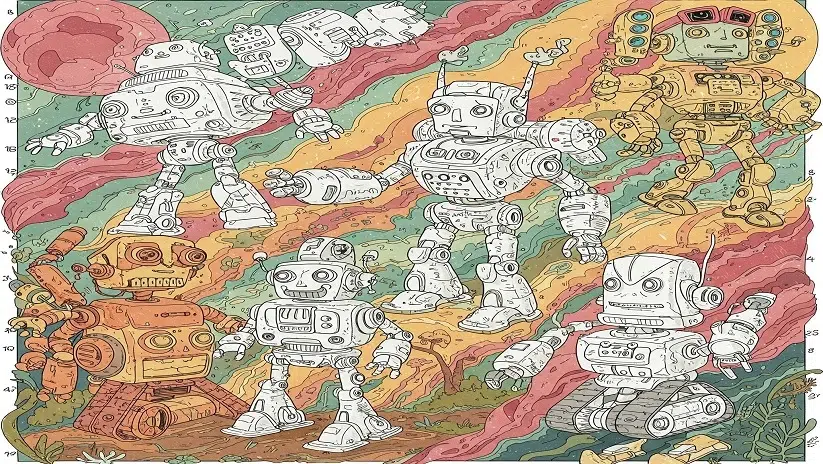In an era where technology and creativity collide, robots dot to dot Nattapong has emerged as a unique blend of art, education, and innovation. This creative concept combines the simplicity of dot-to-dot puzzles with the futuristic appeal of robotics, offering an engaging way for children and adults alike to explore design, problem-solving, and STEM (Science, Technology, Engineering, and Mathematics) principles. Whether you’re a parent, educator, or hobbyist, this article dives into the magic behind these activities, their benefits, and why Nattapong’s work stands out in the world of educational tools.
What Are Robots Dot to Dot Nattapong Puzzles?
Dot-to-dot puzzles have been a childhood staple for generations. By connecting numbered dots in sequence, these puzzles reveal hidden images—from animals to landscapes. Nattapong, a visionary artist and educator, has reimagined this classic activity by infusing it with a modern twist: robots. His designs transform simple numbered dots into intricate robotic figures, encouraging users to think critically about geometry, symmetry, and mechanical design as they connect the dots.
The result? A finished illustration of a robot that can be colored, customized, or even used as a blueprint for real-world projects like coding or 3D modeling. These puzzles aren’t just about fun—they’re a gateway to understanding robotics concepts in an accessible, hands-on way.
Read More : heartbroken stephanie hurt wife of charles hurt
Why Robots Dot to Dot Nattapong Stands Out
-
Educational Value
Nattapong’s puzzles are designed to teach foundational skills. As users connect dots to form robots, they unconsciously practice:-
Number Sequencing: Following numerical order to complete the image.
-
Spatial Awareness: Understanding how lines and shapes create 3D objects.
-
Basic Engineering: Observing how robot parts (e.g., joints, sensors) fit together.
For educators, these activities align with STEM curricula, making them ideal for classrooms or homeschooling.
-
-
Creativity Meets Technology
Once the dot-to-dot robot is complete, the possibilities expand. Users can:-
Color and Personalize: Add details like circuits, armor, or futuristic patterns.
-
Build Digitally: Use the outline to design a robot in apps like Tinkercad or Scratch.
-
Discuss Real-World Robotics: Compare the drawing to actual robots used in industries like healthcare or manufacturing.
-
-
Accessibility for All Ages
Nattapong’s puzzles cater to varying skill levels. Beginners might tackle a 50-dot robot, while advanced users can challenge themselves with 200+ dot designs. This inclusivity makes the activity perfect for family bonding or collaborative learning.
Read More : tech console defstartup
The Role of Nattapong in Modern Edutainment
Nattapong, whose full name and background remain relatively low-key, has gained recognition for merging analog and digital learning. His work emphasizes “learning by doing,” a philosophy that resonates in today’s tech-driven world. By focusing on robots—a subject synonymous with innovation—he taps into the curiosity of younger generations while fostering skills relevant to future careers.
His designs often feature:
-
Modular Components: Robots with interchangeable parts to inspire customization.
-
Thematic Variations: Space robots, rescue bots, or AI companions to spark storytelling.
-
Printable and Digital Formats: Puzzles are available online, making them easy to access globally.
Read More : defstartup console tech
Benefits Beyond the Page: From Dots to Real-World Robotics
Completing a robot dot-to-dot by Nattapong isn’t the end—it’s the beginning. Here’s how these puzzles inspire deeper exploration:
-
Introduction to Coding
After drawing a robot, kids might program a similar one using block-based coding platforms. For example, they could recreate their robot in Scratch and animate its movements. -
3D Modeling and Printing
Advanced users can import their dot-to-dot outlines into 3D software, transforming 2D sketches into tangible models. This bridges art with engineering. -
Robotics Kits Integration
Brands like LEGO Mindstorms or Makeblock offer kits to build programmable robots. Nattapong’s designs can serve as blueprints for these projects.
Read More : charles and stephanie hurt wedding
How to Get Started with Robots Dot to Dot Nattapong
-
Find the Right Puzzle
Search for Nattapong’s printable templates online or purchase activity books. Start with simpler designs to build confidence. -
Gather Supplies
All you need is a pencil, eraser, and markers. For tech integration, use a tablet or computer. -
Expand the Activity
-
Host a robot-design competition with friends.
-
Pair the puzzle with a robotics documentary or YouTube tutorial.
-
Visit a local science museum to see real robots in action.
-
Read More : kelly bates asks supporters not to take out their anger on nbc 10 …
Conclusion: Why Robots Dot to Dot Nattapong Matters
Robots Dot to Dot Nattapong is more than a pastime—it’s a creative catalyst for the next generation of innovators. By blending art with technology, these puzzles demystify robotics, making complex concepts approachable and fun. Whether you’re guiding a child through their first robot design or exploring your own passion for tech, Nattapong’s work proves that sometimes, the simplest ideas have the most profound impact.
Read More : defstartup tech gaming
FAQs About Robots Dot to Dot Nattapong
1. Who is Nattapong, and where can I find his work?
Nattapong is an artist and educator known for creating STEM-focused dot-to-dot puzzles. His robot-themed designs are available on educational websites, activity books, and platforms like Teachers Pay Teachers.
2. Are these puzzles suitable for classrooms?
Absolutely! They align with STEM goals, improve concentration, and can be paired with lessons on robotics or coding.
3. Can I use these puzzles for group activities?
Yes! Collaborate on large dot-to-dot murals or combine individual robots into a “robot city” project.
Read Also : improve dh58goh9.7 software , improve dh58goh9.7



vy1qrc